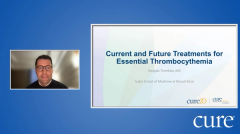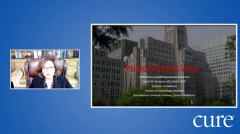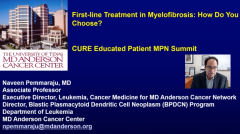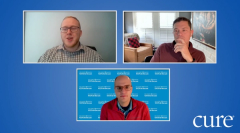
Educated Patient® MPN Summit Current and Future Treatments of Essential Thrombocythemia Presentation: November 19, 2022
Watch Dr. Douglas A. Tremblay, from Mount Sinai, discuss treatment for essential thrombocythemia during the CURE Educated Patient MPN Summit.
Episodes in this series

Some of the main goals of treatments for essential thrombocythemia include reducing disease progression and blood clots while improving symptom burden, but more treatments may be on the horizon focused on specific targets, an expert said.
Dr. Douglas A. Tremblay, assistant professor of medicine at the Icahn School of Medicine at Mount Sinai in New York, spoke about the current and future treatment options for essential thrombocythemia during the CURE® Educated Patient® MPN Summit. He also discussed the treatment landscape with CURE®and the importance of telling care teams about any symptoms that may be present.
Current Treatment Options
Some of the current treatment options for patients with essential thrombocythemia are similar to those to treat polycythemia vera and include antiplatelet agents like aspirin. High-risk patients are typically treated with cytoreductive therapy like hydroxyurea or pegylated interferon, Tremblay said.
“These have been used for decades to reduce the amount of blood cells and decrease the risk of thrombosis (blood clots), which is the primary goal for patients who have essential thrombocythemia,” he told CURE®.
He added that the selective platelet inhibitor Agrylin (anagrelide) is also used for patients with essential thrombocythemia but not in those with polycythemia vera. Treatment with Agrylin may reduce platelet counts but does not have an impact on white or red blood cell counts.
Treatment for essential thrombocythemia has not changed drastically over the past 10 years, but oncologists have learned more about optimal use of these agents, Tremblay said. For example, cancer teams now know more about using interferon for patients with essential thrombocythemia and about the use of Agrylin in the second-line setting of this disease as well. Oncologists have also learned more through risk stratification about what patients may benefit the most from cytoreductive therapy and in which patients it may not be necessary.
Tremblay also mentioned that the knowledge base has grown regarding how to intervene to improve symptoms in patients.
“Even though they may have one of the more indolent versions of myeloproliferative neoplasms, significant and potentially debilitating symptoms can occur (with essential thrombocythemia),” he explained. “So how do these current drugs really stack up to each other in terms of their ability to reduce symptoms and improve symptoms for patients? This is something we are beginning to learn more about.”
Unmet Needs in the Area
Patients with high-risk essential thrombocythemia who are treated with cytoreductive therapy may still have blood clots, so more treatments are needed to address that increased thrombosis risk, Tremblay said. He added that there is also inadequate symptom control with standard therapy.
One question that remains is whether any of the available drugs prevent disease progression to more aggressive forms of myeloproliferative neoplasms like myelofibrosis or acute myeloid leukemia (or MPN blast phase).
“For a lot of the current therapies, it’s really unclear,” Tremblay said. “And it’s probably unlikely that they significantly reduce the risk for progression. So how would these new therapies employ to accomplish those goals?”
Several drugs are currently in the pipeline, with one recently being approved by the Food and Drug Administration called Besremi (ropeginterferon alfa-2b-njft) for the treatment of polycythemia vera. Trials are currently being conducted to see if Besremi can improve outcomes in patients who had resistance or intolerance to hydroxyurea and whether it may have an effect on blood clot events.
Tremblay said that the “more exciting strategy” currently being studied for patients with essential thrombocythemia is LSD1 inhibition.
“This protein is important for the transition of stem cells in the bone marrow to megakaryocytes, which make platelets,” he explained. “There’s a lot of other factors that go into its ability to reduce inflammatory cytokines which are contributing to the symptoms of the disease, as well as these different growth factors which may impact bone marrow fibrosis.”
The drug bomedemstat is currently being developed for both myelofibrosis and essential thrombocythemia and targets LSD1. Preliminary clinical data in patients with essential thrombocythemia have demonstrated success in reducing platelet counts while normalizing white blood cell counts. Tremblay noted that bomedemstat keeps hemoglobin counts stable in patients with essential thrombocythemia, “which is unique among other cytoreductive therapies which reduce all counts.”
He added, “It also may improve the burden of (essential thrombocythemia) related symptoms especially fatigue that patients with (essential thrombocythemia) can experience. And importantly, it does look at the amount of mutation burden that someone has, which we think may be a surrogate for progression, although it hasn’t fully been established.”
For more news on cancer updates, research and education, don’t forget to












